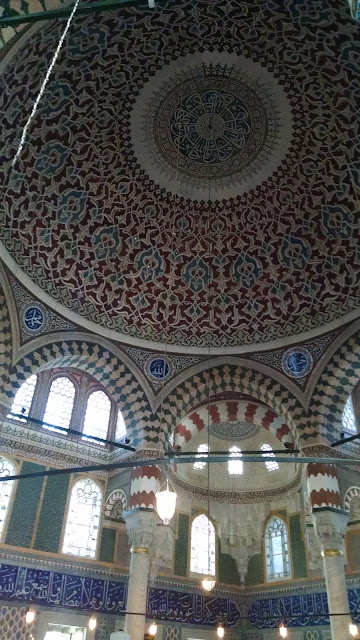I started off my day looking for the Hagia Sophia (Ayasofya). My hostel is located in Sultanahmet, the "old city" district of Istanbul, and many of the oldest, most famous buildings are all densely packed into this area. Back in ancient times there were no cars, trains, trams, etc. so everything in the city center was within walking distance, which makes for some convenient touristing!
Or so I thought. I followed my gmaps to what I thought was the Hagia Sophia, but turns out was actually the Sultan's Tombs, which is part of the Hagia Sophia grounds/complex, but for touristing purposes, is separated. The Sultan's Tombs are free, whereas Hagia Sophia has long ticket and entry lines to get in.
 |
| The innocuous entrance. There's a security guard posted here, you have to walk through a metal detector and put your bag through a scanner. There were also signs to cover your head, which I did with some amount of difficulty, I think I looked like a mummy. |
 |
| This is inside the tomb of Sultan Mehmet III, constructed in 1608. |
 |
| The tomb is an octagonal shape and covered with a dome. |
 |
| The amount of detail put into decorating is amazing, every square inch is covered with tile, each panel of tiles is different, and these tiles weren't mass produced in a factory, they are handmade Iznik tiles. |
 |
| Tiles with Arabic calligraphy. |
 |
| In front of the next tomb, the tomb of Sultan Selim II, this sign reports how the Louvre stole a whole tile panel from the tomb! The panel was a good deal lighter colored than the identical tile panel on the other side, I guess replica Iznik tiles aren't nearly as good as the real thing. |
 |
The inside tomb arrangement looks similar to the first. According to a friendly security guard, the large tomb in the middle is the sultan's tomb. The medium-sized ones flanking is are his wives. The little tombs are for the children. The white turban-looking wrappings indicate a male child.
The bodies are actually interred underground, these structures are just a representation of the tomb, although I don't know if they were placed back in 1600 or if that's something the museum curators did later. |
 |
| A different geometric design in this dome, which was constructed for Sultan Selim II while he was still alive. Construction had not finished by the time of his death, but was eventually completed 3 years later in 1577. |
 |
| A closeup of some of the Iznik tiles. Iznik is a town in Turkey that was famous for ceramic productions from the late 1400s to the late 1600s. |
 |
| Prior to this, Turkish artisans were unable to make porcelain, and could only produce fritware. |
 |
A lot of inspiration was drawn from Chinese ceramics, which were treasured by Ottoman sultans. They believed that the glaze on the ceramics would change color in the presence of poison, an ever-present danger for rulers during this time.
Much of the early Iznik pottery lacked color; they were only able to produce blue and white ceramics. It wasn't until later that green, and finally red dyes and colors were introduced. As such, the tiles can be roughly dated just by looking at the colors used. |
Ok last tomb I promise. (There are actually 5 in total but I got bored and didn't go to all of them).
This is the tomb of Sultan Mustafa I and Sultan Ibrahim.
 |
| Looks a little different than the other ones from the outside... |
 |
No tiles, no calligraphy, no brilliant blue and green colors, jut old brick and some simple motifs done in paint.
This building was actually not built specifically as a tomb, but is an old structure from the time of the Byzantine empire that was later transferred into a tomb. It is the former Baptistery building of Hagia Sophia, thought to be older than Hagia Sophia itself.
A tell-tale sign of Byzantine-turned-Ottoman buildings is the red brick walls. |
 |
| The inside looks similarly unadorned, and you can see the remains of a Byzantine paint job, touched up, I'm sure. |
 |
| J-k!!! I trick you. Tomb of Sultan Murad III, built in 1599. This was the largest tomb, and had really pretty stained glass windows that the other tombs didn't have. |
















That's super cool. How did you remember all of this as you were walking around? I feel like one of my weak areas is memory...as in when I read or hear something if I am not paying attention I can't recall the details later. Ugh.
ReplyDeleteThat's really sad that there are so many children's tombs with him. I wonder if they died as children or his adult children were buried there afterwards.
The whole interred/tomb thing reminds me a lot of The DaVinci code.
Haha yah, I normally wouldn't remember but I made myself memorize it so I could write about it later. I also took pictures of some of the signs/placards as a cheat sheet. XD
Delete